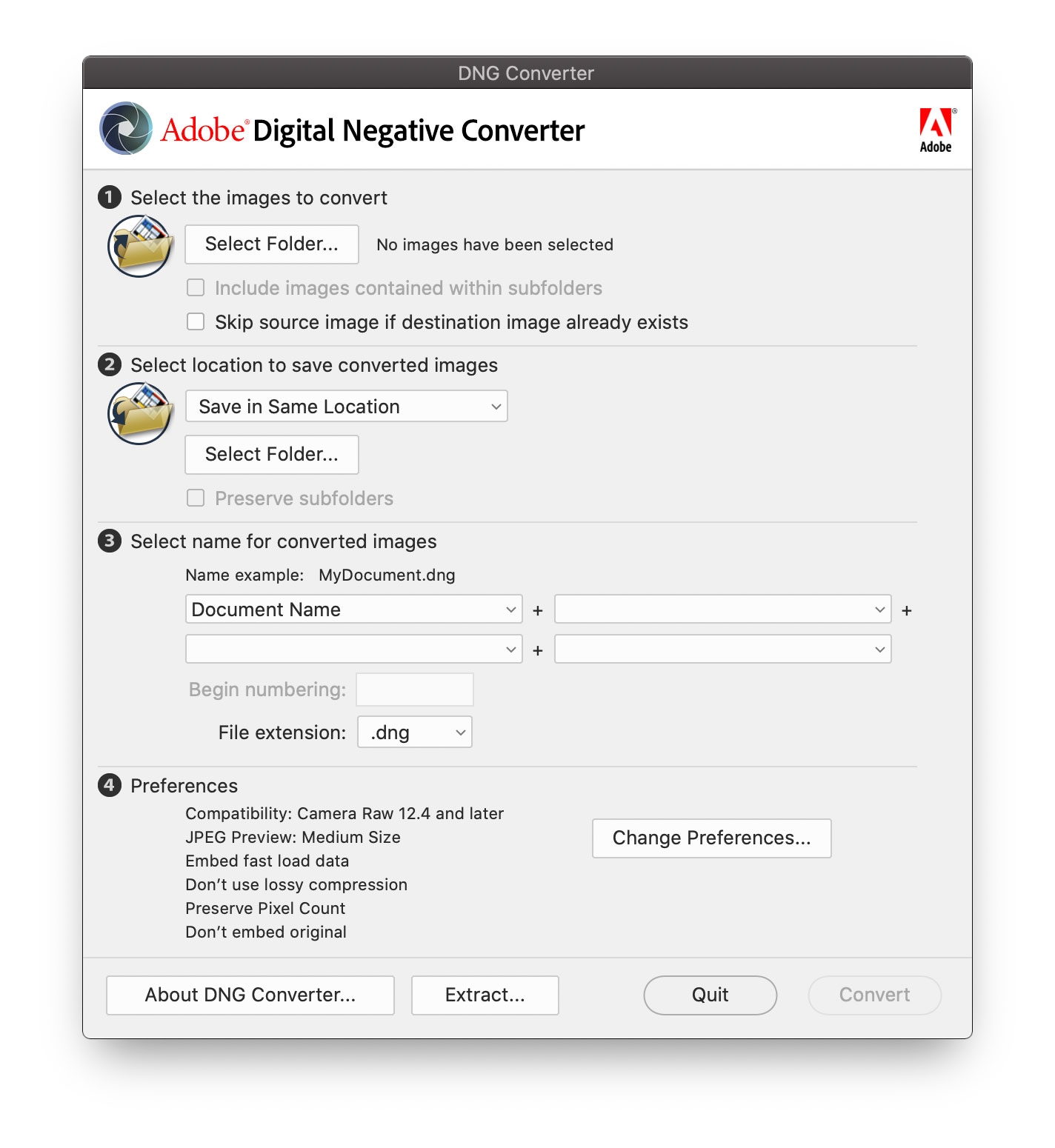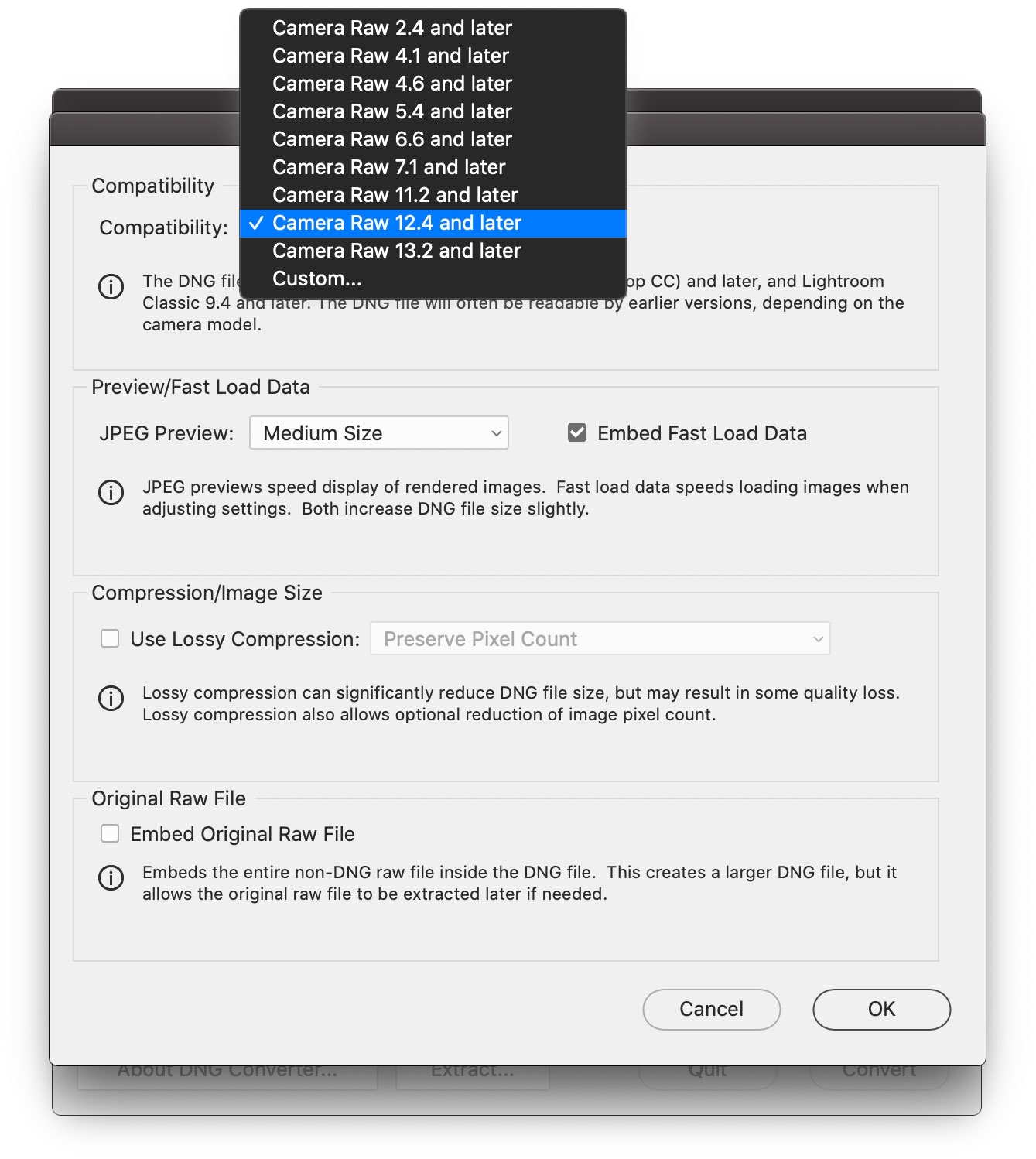The Adobe DNG Converter enables you to easily convert photographic camera-specific raw files from supported cameras to a more than universal DNG raw file. Another benefit of using the DNG Converter is astern compatibility.
Adobe Dng Converter Download Mac Os X

Workflow overview

For conceptual data most raw files and the DNG format, and to understand why you should convert your files to DNG, run into theAppendix.
Adobe provides backwards compatibility for the latest cameras for use in older versions of Photoshop, Lightroom, Bridge, After Effects, and Photoshop Elements through the DNG Converter.
Download the DNG Converter
| macOS | Windows | ||
| Download latest DNG Converter for macOS | Download latest DNG Converter for Windows | ||
| Processor | Multicore Intel® processor with 64-scrap back up or M1 Apple Silicon processor | Processor | Intel®, AMD, or ARM processor with 64-fleck support; 2 GHz or faster processor |
| Operating System | macOS Catalina (version x.15) or later | Operating System | Windows x 64-chip (version 1909) or afterward; LTSC versions are not supported |
Installation
- Open the downloaded file and double-click the DNG Converter executable file.
- Follow the onscreen instructions.
The DNG Converter is now bachelor in your Programs (Windows) or Applications (macOS) directory. The installation utility is designed to as well install a set of color profiles required for the DNG Converter to function properly. These profiles are copied to a common resource location.
Convert images

- Launch the DNG Converter past double-clicking its icon. Alternatively, drag and driblet individual images or a folder of images directly onto the Adobe DNG Converter icon. This action automatically launches the converter.
- Select the binder of images you'd like to convert to DNG.
- Select the location where you desire to salve the converted DNG files.
- Select a naming blueprint for the new DNG files:
Certificate Name: The existing name of the file is used with the DNG extension added.
Add serial numbers or messages to the name: Avant-garde patterns; an case of the resulting name appears afterwards Name Example. - Specify the following boosted settings for the DNG file names:
Begin numbering: Enter the starting serial number if you'd like information technology to exist unlike from 1.
File Extension: The file extension is automatically set to DNG. You can choose the extension to be either capital letter or lowercase. - If necessary, change thecompatibility preferences.
- Click Convert. A dialog box showing the condition of the conversion appears.
Specify compatibility preferences

To change compatibility preferences, follow these steps:
- In the Preferences section of the DNG Converter dialog box, click Change Preferences.
- Choose one of the following options:
Camera Raw ii.4 and after: The DNG file volition be readable by Camera Raw two.iv (Photoshop CS) and later, and Lightroom ane.0 and later
Camera Raw 4.1 and later: The DNG file volition be readable by Camera Raw 4.one (Photoshop CS3) and later, and Lightroom one.i and later. The DNG file will often be readable by earlier versions, depending on the camera model.
Camera Raw 4.half dozen and later: The DNG file will be readable by Camera Raw 4.6 (Photoshop CS3) and later on, and Lightroom 2.1 and later on. The DNG file will often exist readable by earlier versions, depending on the camera model.
Camera Raw five.4 and afterwards: The DNG file will be readable by Camera Raw 5.4 (Photoshop CS4) and afterward, and Lightroom 2.4 and later on. The DNG file will oft exist readable by earlier versions, depending on the camera model.
Camera Raw 6.half dozen and subsequently: The DNG file will exist readable past Camera Raw half-dozen.6 (Photoshop CS5) and later on, and Lightroom three.6 and later. The DNG file volition frequently be readable past earlier versions, depending on the camera model.
Photographic camera Raw 7.1 and later: The DNG file will be readable by Photographic camera Raw 7.i (Photoshop CS6) and afterwards, and Lightroom iv.i and afterward. The DNG file will ofttimes be readable by earlier versions, depending on the camera model.
Photographic camera Raw 11.2 and later: The DNG file will be readable past Camera Raw 11.2(Photoshop 20) and later, and Lightroom 8.2 and later on. The DNG file will oftentimes be readable by earlier versions, depending on the camera model.
Camera Raw 12.4 and later on: The DNG file volition exist readable by Camera Raw 12.four (Photoshop 21) and after, and Lightroom nine.4 and later. The DNG file will often be readable by before versions, depending on the camera model.
Camera Raw 13.2 and later: The DNG file will be readable by Photographic camera Raw 13.2 (Photoshop 22) and later, and Lightroom x.two and afterward. The DNG file volition oft be readable past earlier versions, depending on the photographic camera model.
Custom:- Backward Version: DNG 1.i, DNG ane.three, DNG 1.4, or DNG 1.6 (default i.6)
- Linear (demosaiced): The image data is stored in an interpolated ("demosaiced") format. This choice is useful if a camera's particular mosaic design is not supported by a DNG reader. The default mosaic format maximizes the extent of data preserved. Mosaic image information tin exist converted to linear data, but the opposite is not possible.
- Uncompressed: No compression is practical to the raw image data.
- Click OK.
Video | The advantages of the DNG file format
For a video walkthrough of converting your raw files to DNG using the Adobe DNG Converter, see vii:12-9:44 in this video...
Appendix: Raw files and DNG
A raw file contains the "raw" data captured by the digital camera sensor before it has been converted to JPEG or TIFF formats. Cameras that create JPEG or TIFF files process (and in the case of JPEG files, compress) the sensor data. When working with raw files, the file is not compressed or processed in the camera. Instead, software gives the user consummate control over the conversion settings. For case, white balance is non applied to the raw file just is stored with the file so the software can default to the originally-intended setting. Other information contained in a DNG file includes standard EXIF metadata (just like in JPEG files), date, fourth dimension, photographic camera used, and camera settings.
Raw files offer the following benefits:
- Smaller files than uncompressed TIFF
- Does not have the artifacts of compressed JPEGs
- Many key camera parameters, such equally white balance, tin can exist modified fifty-fifty afterwards the paradigm is captured
- You lot have complete control over conversion settings rather than letting the camera decide
- Access to xvi-bit data for greater item and fidelity
- Flexibility of converting a single file using multiple conversion settings
The Digital Negative (DNG) format
Digital Negative (DNG) is an openly published raw file specification that stores the "raw" pixel data captured past the digital camera sensor before it has been converted to JPEG or TIFF formats, along with standard EXIF metadata, appointment, fourth dimension, camera used, and camera settings. This format is freely available for other software and hardware vendors to support.
Why convert to the DNG format?
Unlike almost manufacturer-specific raw formats, the Digital Negative is an openly published specification that not merely is supported by Adobe, but is also freely bachelor for other software and hardware vendors to support. Consequently, it can be a safer file format to use for long-term archival purposes. Archiving your file as a digital negative eliminates worries that the raw file will no longer be readable once the camera format that created it becomes obsolete.
The Digital Negative specification allows for not merely all of the pixel information stored in current raw formats, simply also for all of the additional, proprietary metadata that many manufacturers include. The Adobe DNG Converter may, in some cases, ignore some of this proprietary metadata, and just include the basic information necessary for creating a high-quality image file. The original raw file, however, tin also be embedded in the new DNG format to ensure that proprietary metadata from the manufacturer is not lost.
Adobe Dng Converter Download Mac Os X
Adobe Dng Converter Download Mac Os X. There are any Adobe Dng Converter Download Mac Os X in here.
